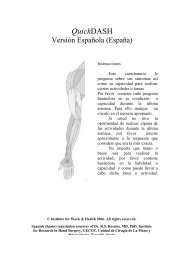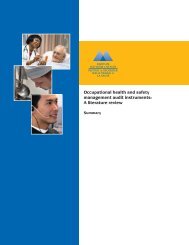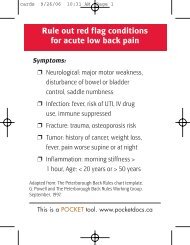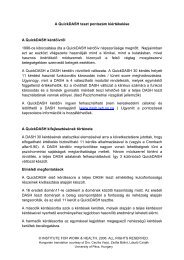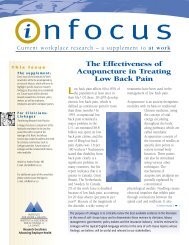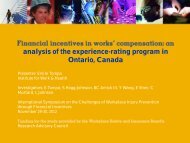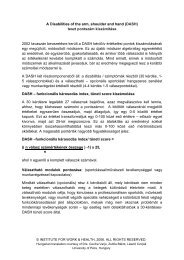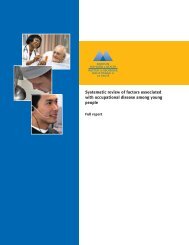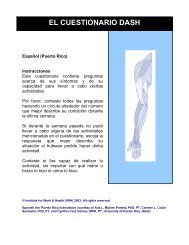A systematic review of injury/illness prevention and loss control ...
A systematic review of injury/illness prevention and loss control ...
A systematic review of injury/illness prevention and loss control ...
- No tags were found...
Create successful ePaper yourself
Turn your PDF publications into a flip-book with our unique Google optimized e-Paper software.
interventions provide an insufficient level <strong>of</strong> evidence to enable us to drawconclusions or make recommendations.There was insufficient evidence for the following interventions:• bricklaying method• new chair• <strong>loss</strong> <strong>control</strong> as a service• new <strong>of</strong>fice• participatory ergonomics• hearing protectors• safety training• skin care training• training <strong>and</strong> equipment forklifts.Some types <strong>of</strong> interventions were not included in the evidence synthesisdespite the impact they have on employees, because they did not make it tothe data extraction phase. These studies were on: evaluating confined spaces,fall protection, driver injuries not as a result <strong>of</strong> driving, hazardcommunication, respiratory protection or power presses. These areas arefrequently associated with many injuries/<strong>illness</strong>es (including deaths), citedviolations by OSHA <strong>and</strong> workers’ compensation claims. None <strong>of</strong> thepublications from the grey literature, identified by content experts, made it tothe data extraction phase either.Also worthy <strong>of</strong> noting is that, <strong>of</strong> the 72 studies identified as evaluating safetyclimate/culture, only one that met the criteria <strong>of</strong> being an IPC <strong>and</strong> having arelevant outcome made it to the evidence synthesis stage (Zohar 2002). Theoutcomes in the majority <strong>of</strong> the safety climate/culture articles were change inbehaviour or per cent safe behaviours, <strong>and</strong> these outcomes were not includedin this <strong>review</strong>. Several <strong>of</strong> the safety climate/culture articles were classified asa measurement tool or measurement model, but did not meet the IPCrelevancy criteria.The majority <strong>of</strong> high quality studies were completed in <strong>of</strong>fice environments<strong>and</strong> focused on reports <strong>of</strong> pain <strong>and</strong> discomfort. Each high quality study wasdesigned to limit threats to internal <strong>and</strong> external validity. However, fewmeasured similar outcomes, making it a challenge to integrate findings orgeneralize the findings to other business sectors.One potential action for stakeholders would be to discuss how to completehigh quality research in the sectors that were under-represented in the <strong>review</strong>.These sectors include construction <strong>and</strong> manufacturing, which generally havea greater number <strong>of</strong> hazards than those presented by <strong>of</strong>fice environments.Due to the use <strong>of</strong> technology, construction <strong>and</strong> manufacturing environmentshave similar ergonomic risks as <strong>of</strong>fice environments plus additional hazardssuch as confined spaces, working at heights, chemical exposures, etc. TheA <strong>systematic</strong> <strong>review</strong> <strong>of</strong> <strong>injury</strong>/<strong>illness</strong> <strong>prevention</strong> <strong>and</strong> <strong>loss</strong> <strong>control</strong>programs (IPCs)35



